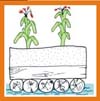From TKWB - Traditional Knowledge World Bank
Jump to navigation
Jump to search
| GENERAL DEFINITION OF THE TECHNIQUE |

|
| Technique: |
FLOATING GARDENS |
|
Definition characters description and diffusion
Among the pre-Columbian techniques for using humid areas, the floating gardens called chinampa were disseminated by the Toltec population after the fall of Tula in 1165 AD. The water of the marshlands irrigates the soil where the plants grow, directly from below, supported by wooden bases that in some cases may actually float.
General characters description and diffusion
Nowadays, at Xochimilco, a town 30 kilometers from Mexico City and whose name means 'place of the fields of flowers', the chinampa are arranged in chequered cultivations. Like islands in the freshwater lagoon, they are seperated by a regular layout of canals, which can be navigated by flat bottomed boats. Today, the situation is closer to the feixe than to gardens on floating rafts. The chinampa, with plants which direclty absorb the necessary water through their roots, are an example of the creation of a space that can be cultivated when there is water in excess. Large wooden rafts are anchored on lakes and marshes. A layer of soil with earth and manure is spread on top. Humidity passes directly from the wood to the roots of the plants, which thus obtain the water they need without irrigation. This original water control practice dates back to the 2nd millennium BC, but it is with the classical and pre-classical civilizatoins that the natural depressions and cavities full of water were systematically organized and supplied by means of collection areas, that were no less than the pyramids and monumental architecture. Water management developed specific water control practices for the purpose of limiting excesses. This was the case with the Maya settlements in Yucatan that can be defined as rainforest oases.
Advantages and sustainability
Marsh waters irrigate plants through a chequered system of canals and cultivations. This systems takes advantage of the excess of water while using minimal amounts with very little waste to irrigate the plants through absoprtion of the water through wood, soil, and directly into the roots of the plants.
Images
Deepening
|
TRADITIONAL TECHNIQUE DATA
| Technique |
| FLOATING GARDENS |
| Icon |
 |
| Cathegory |
| B - Agriculture |
| Identification code |
| B10g |
| Author: |
|
| Other authors: |
|
| Reference: |
|
|
|